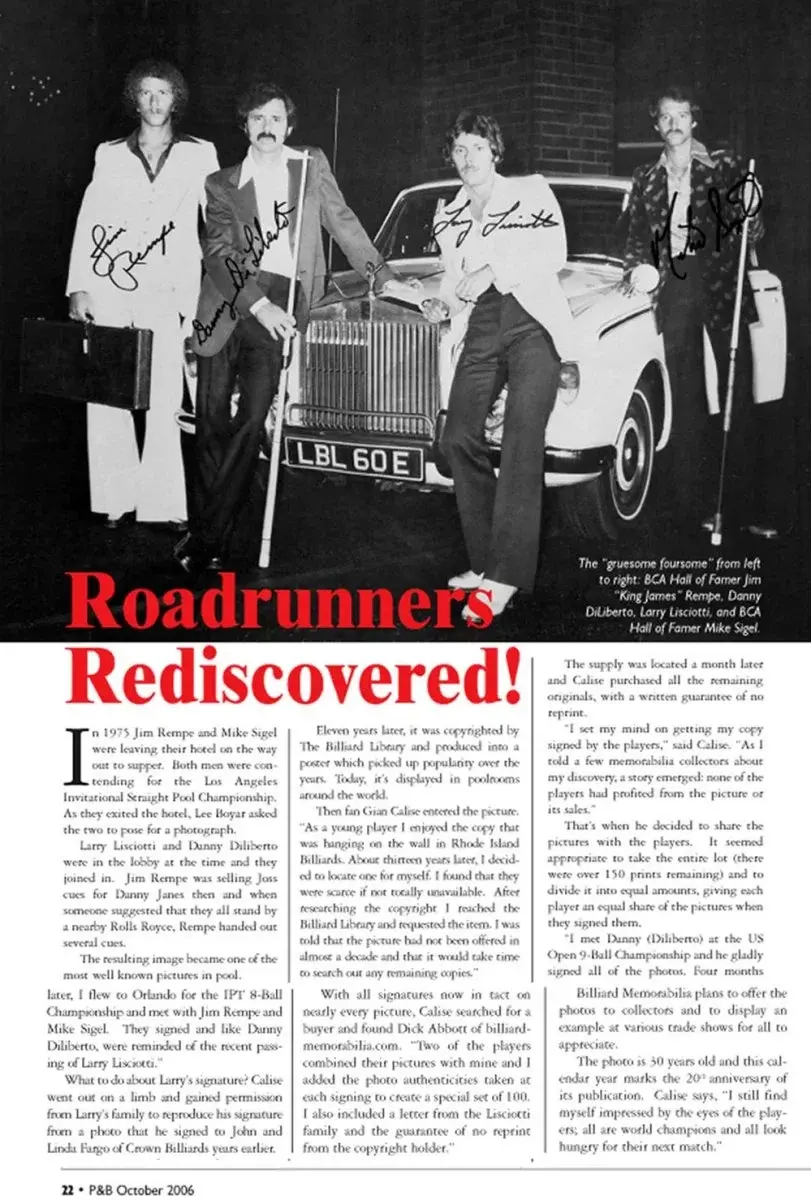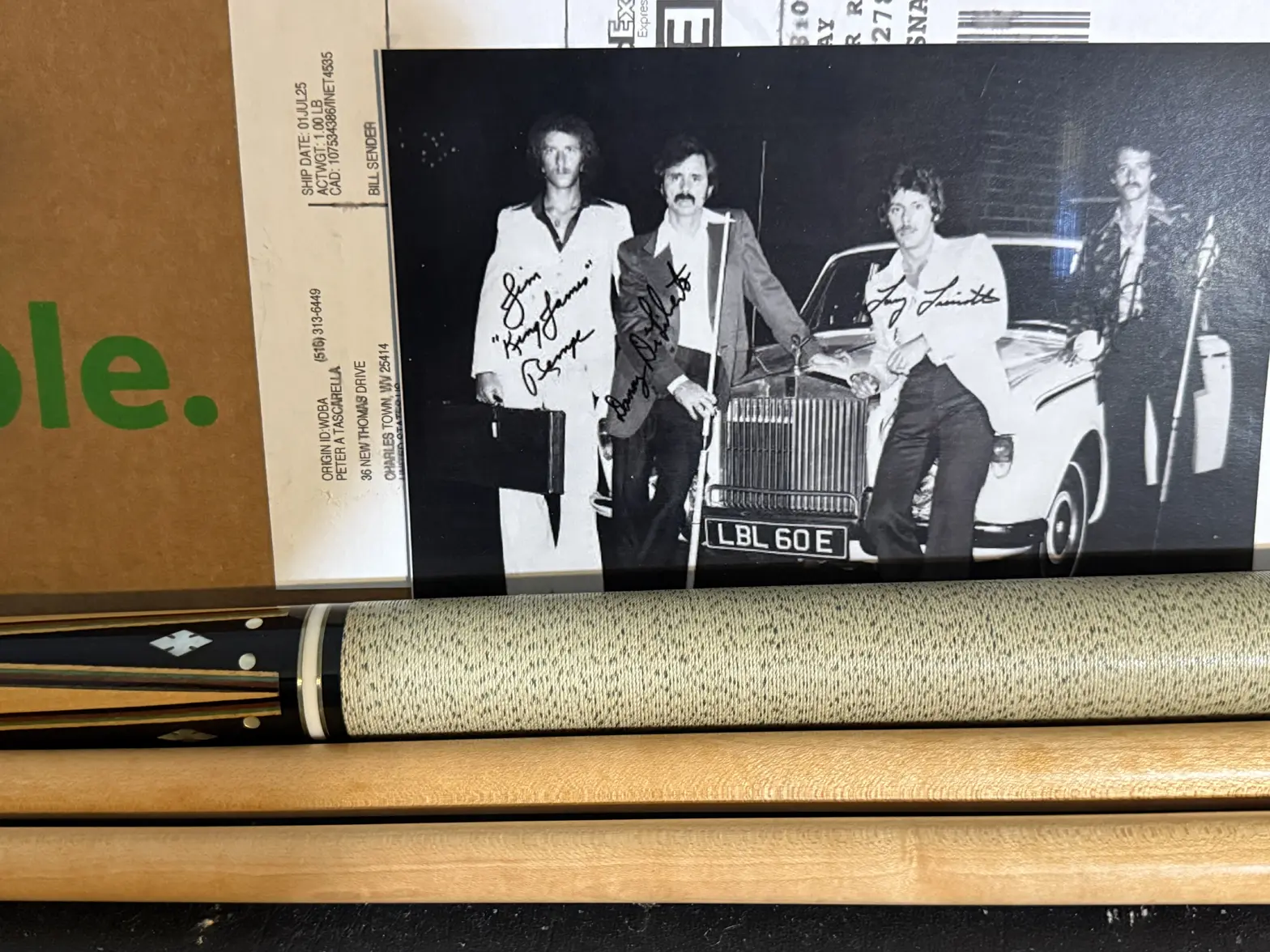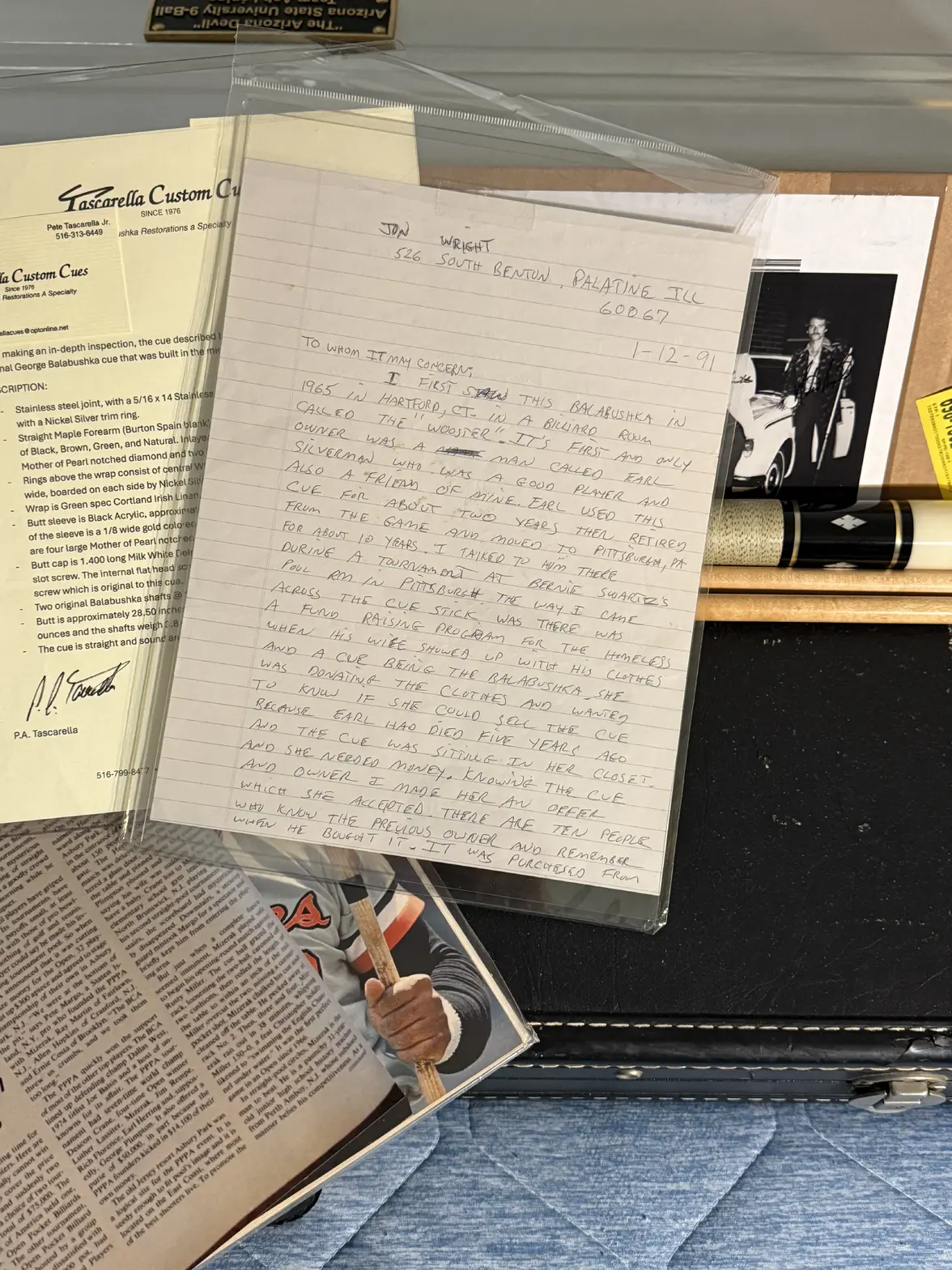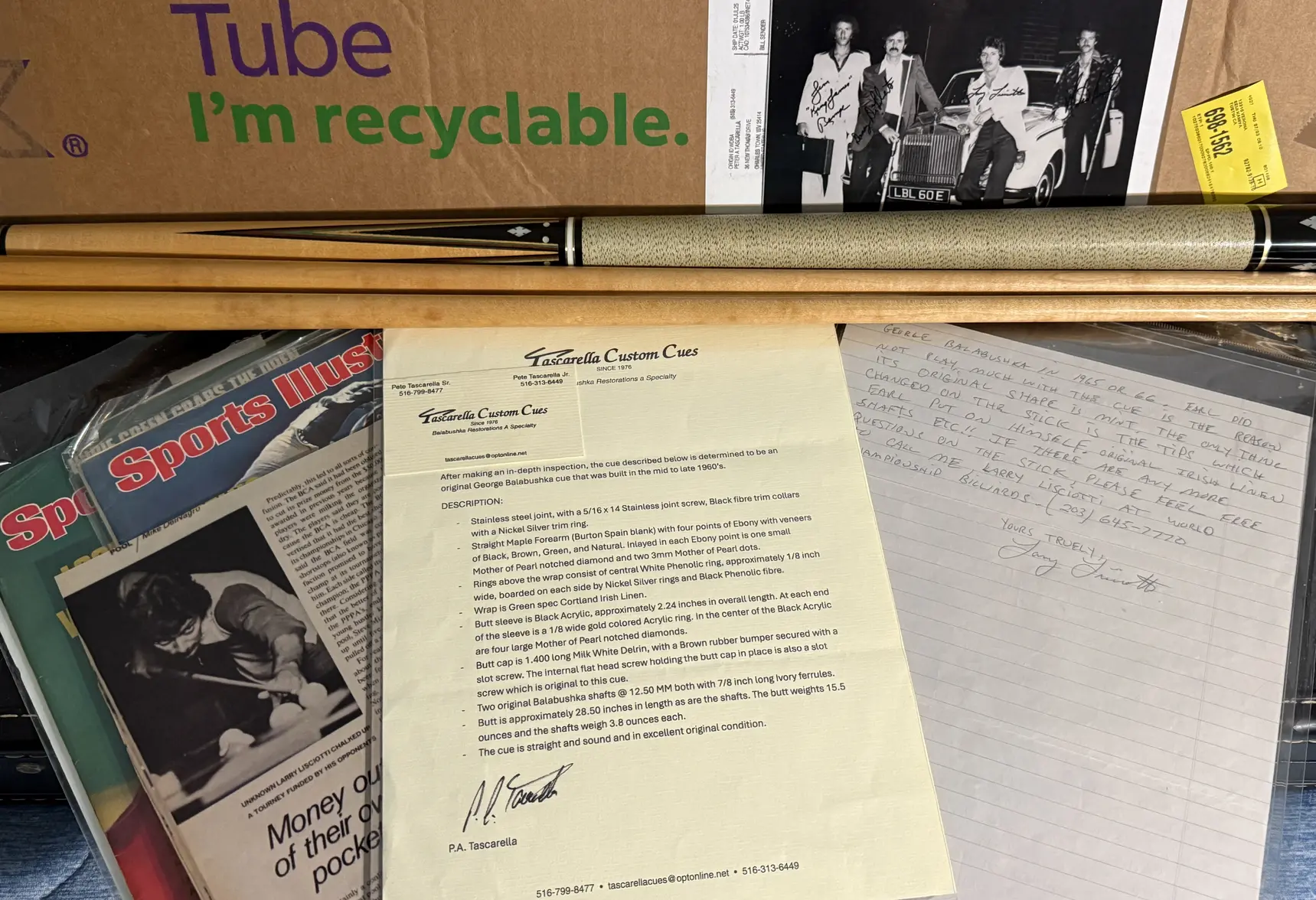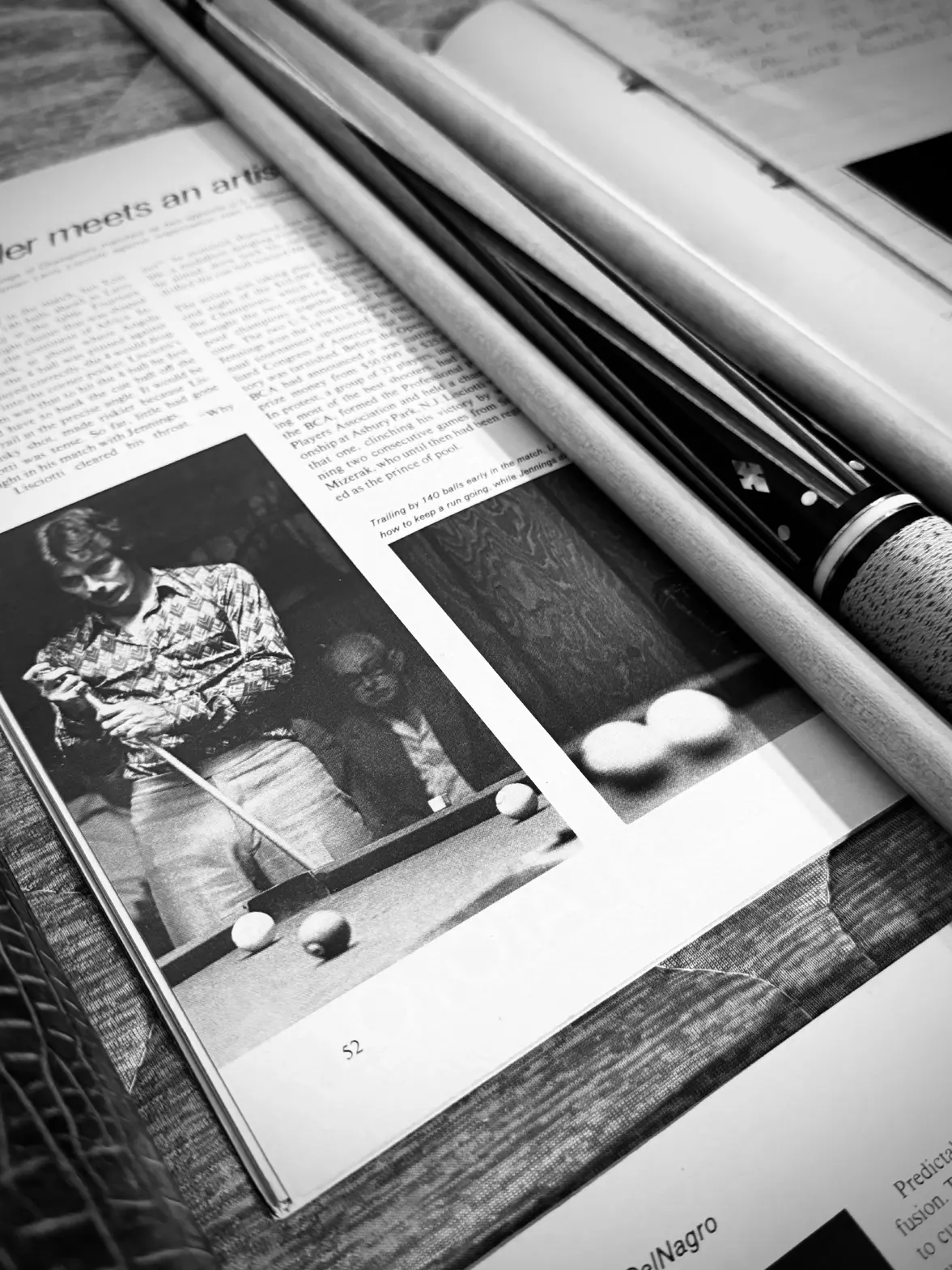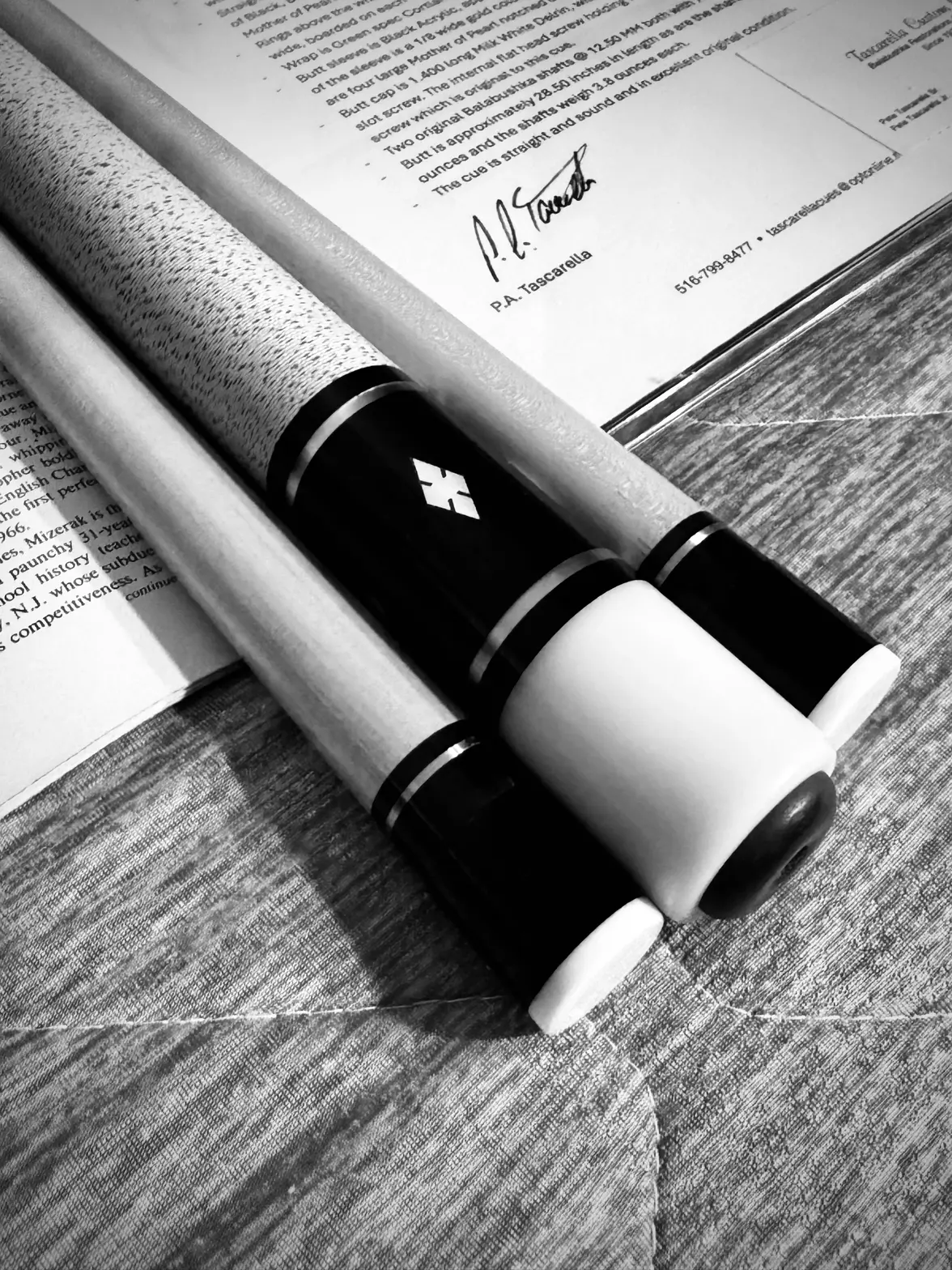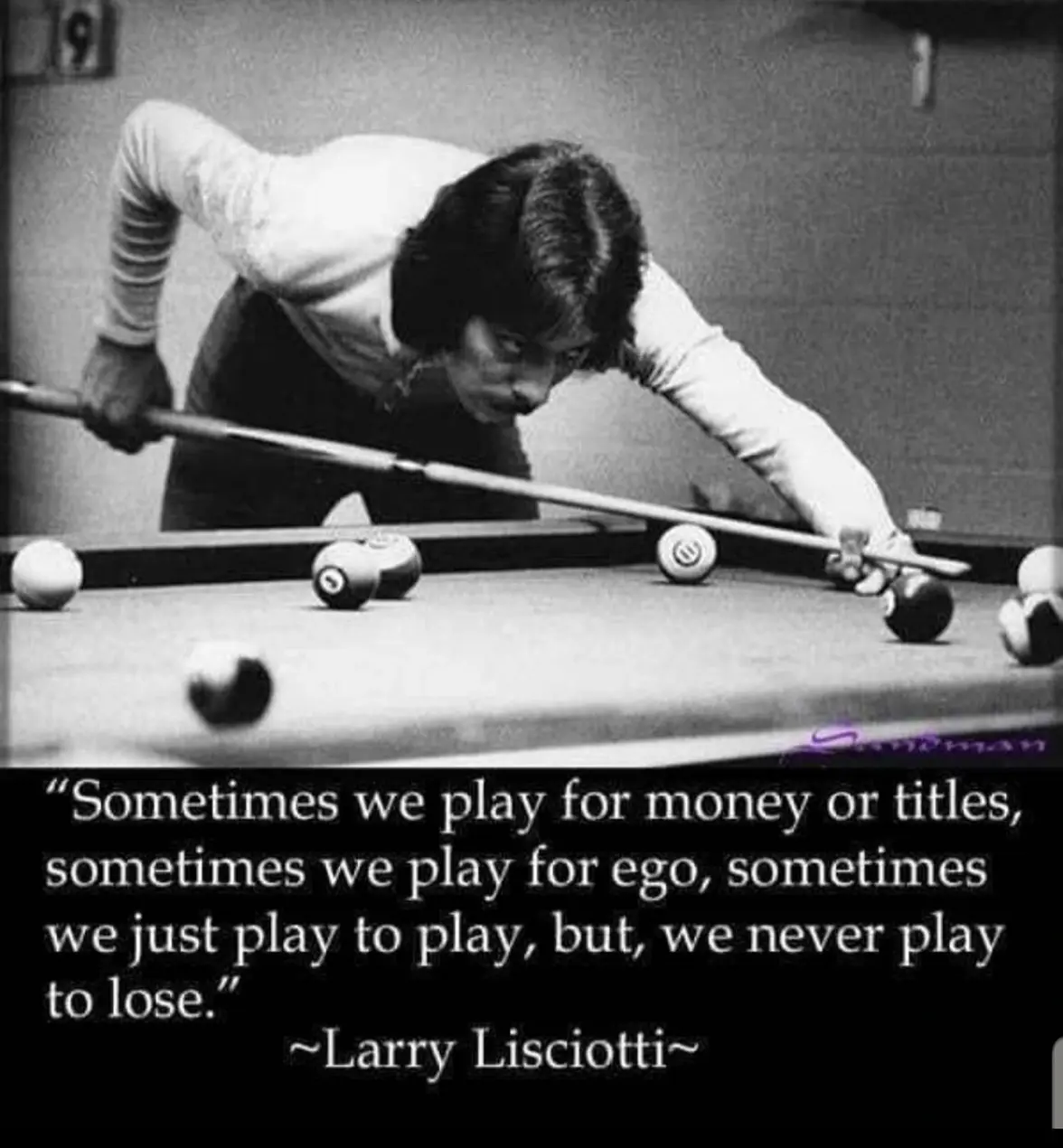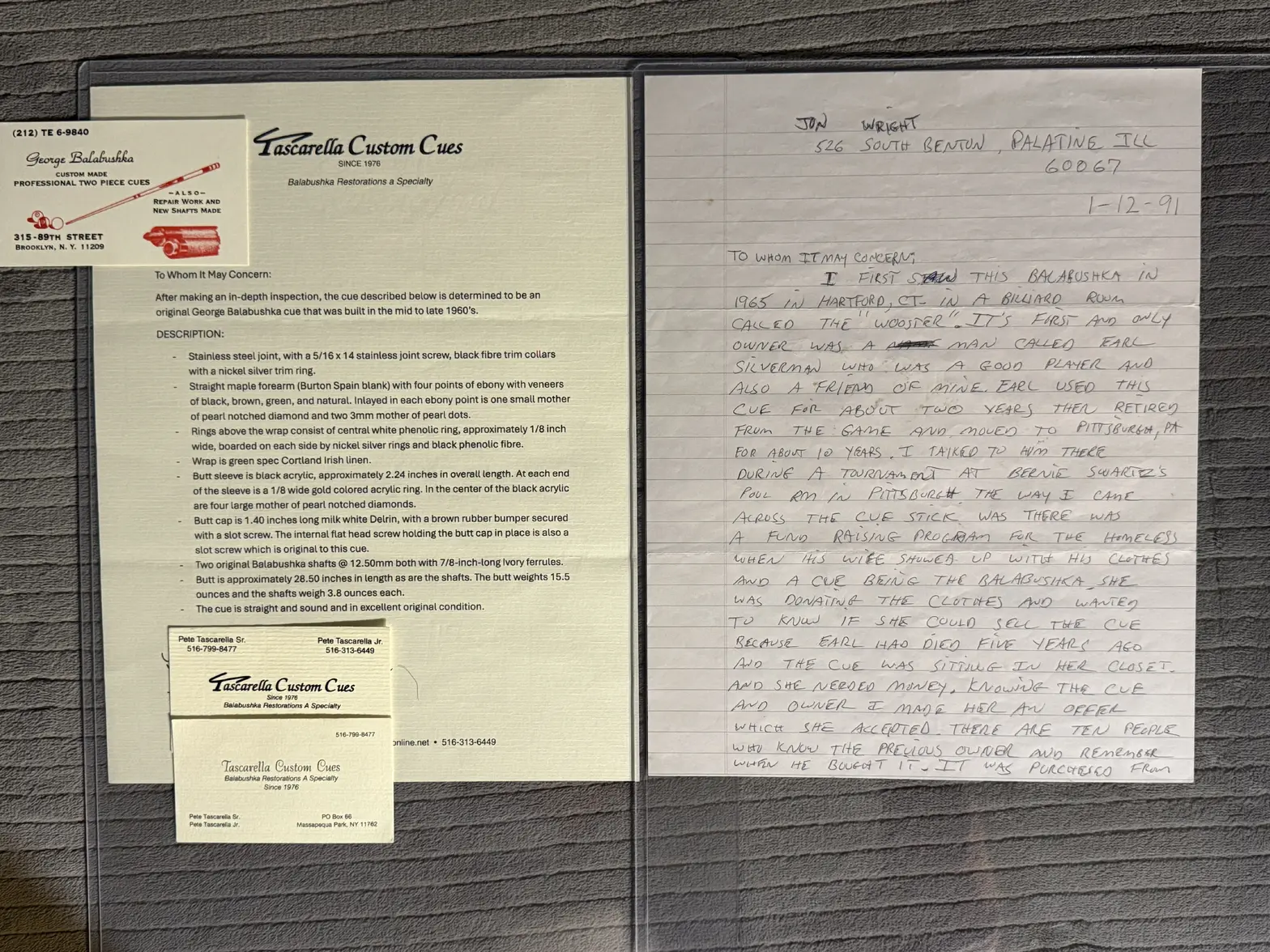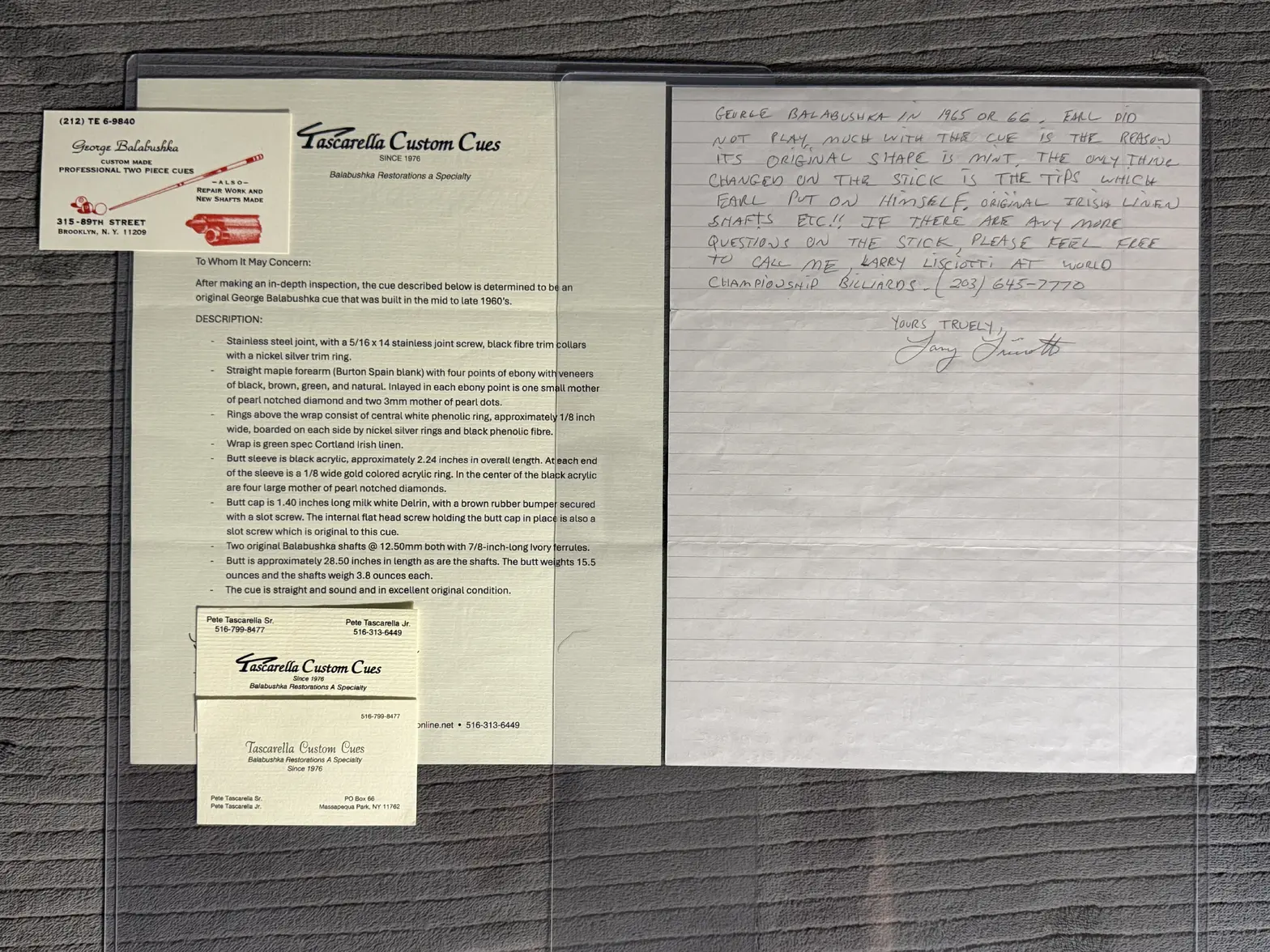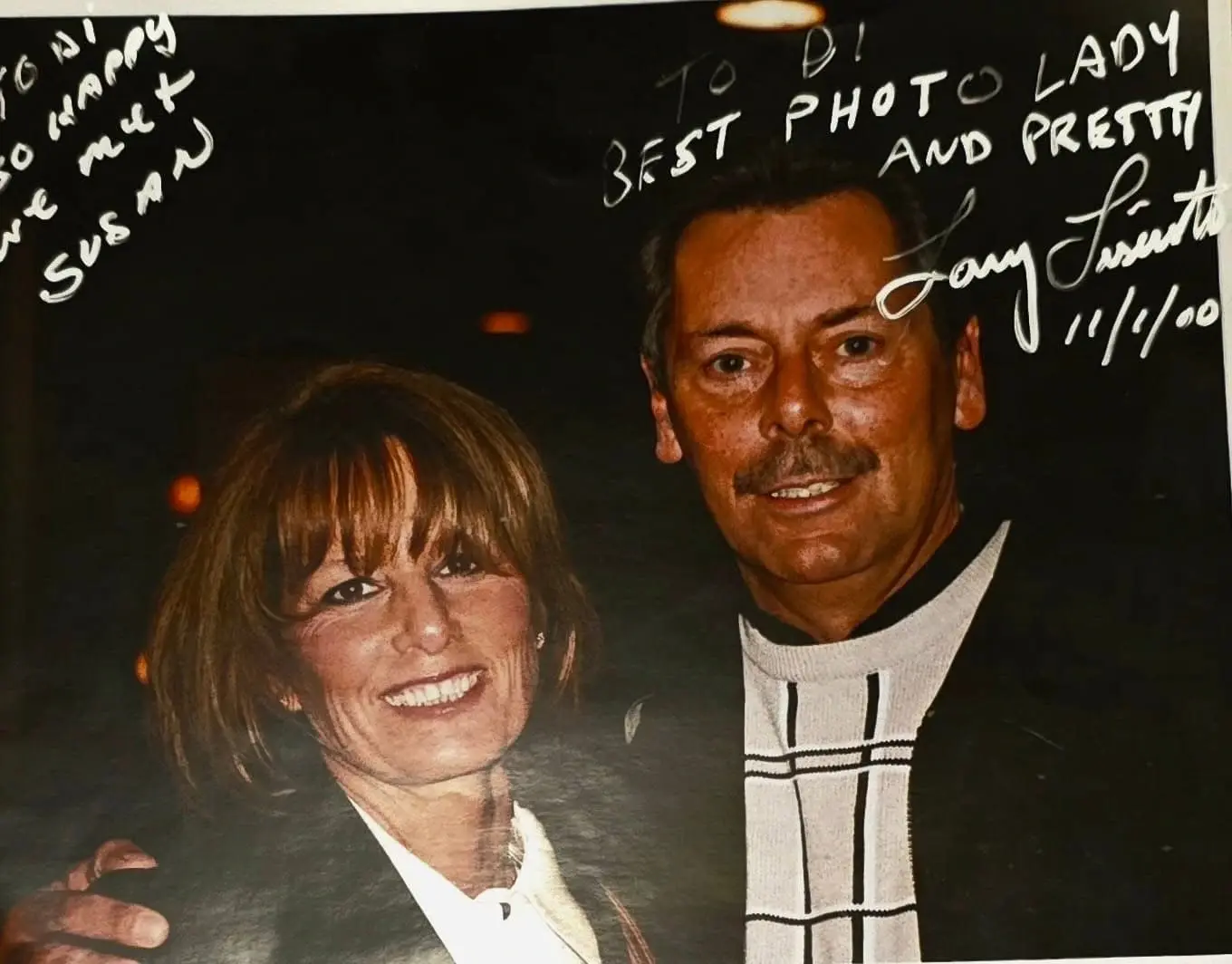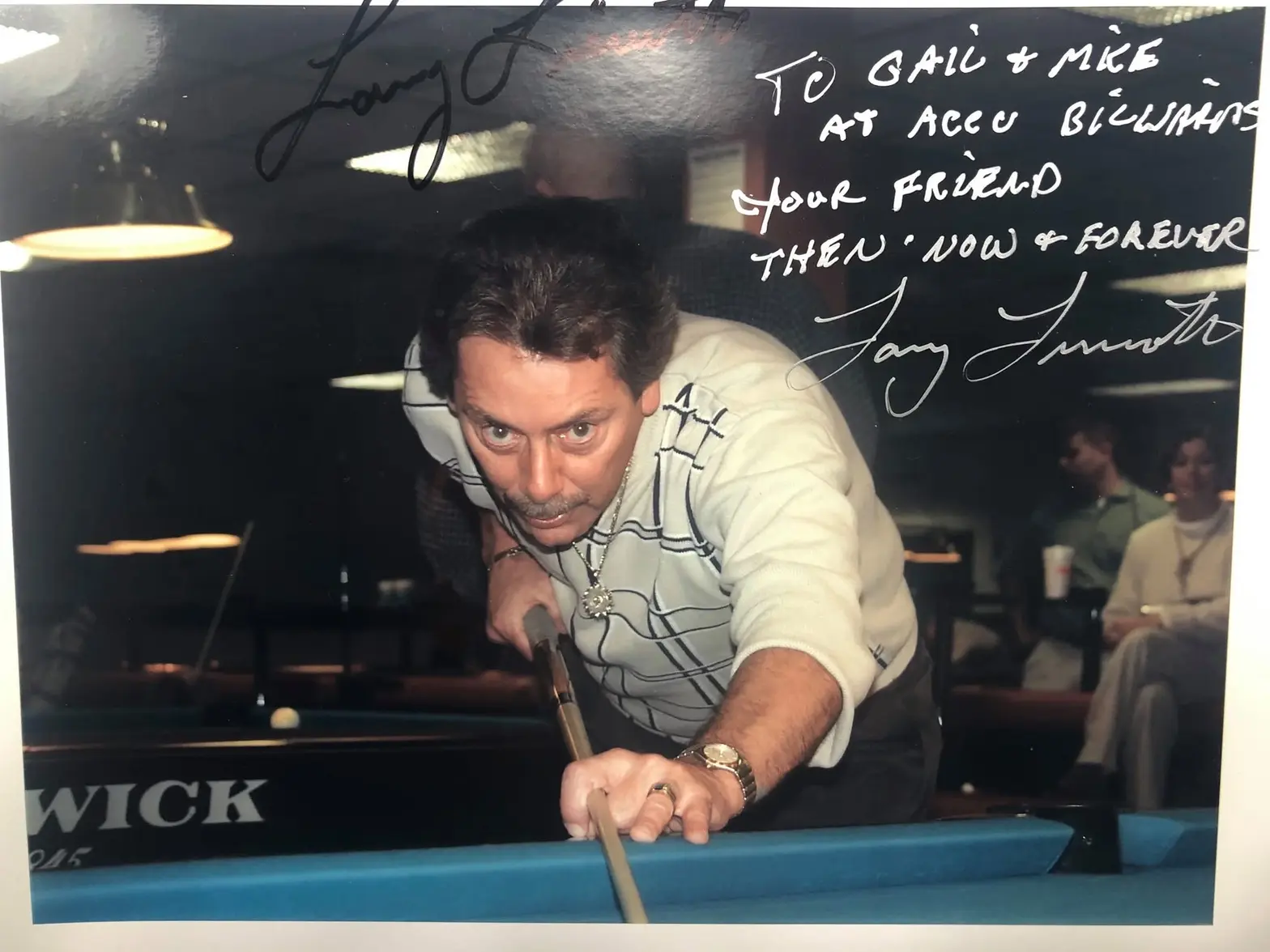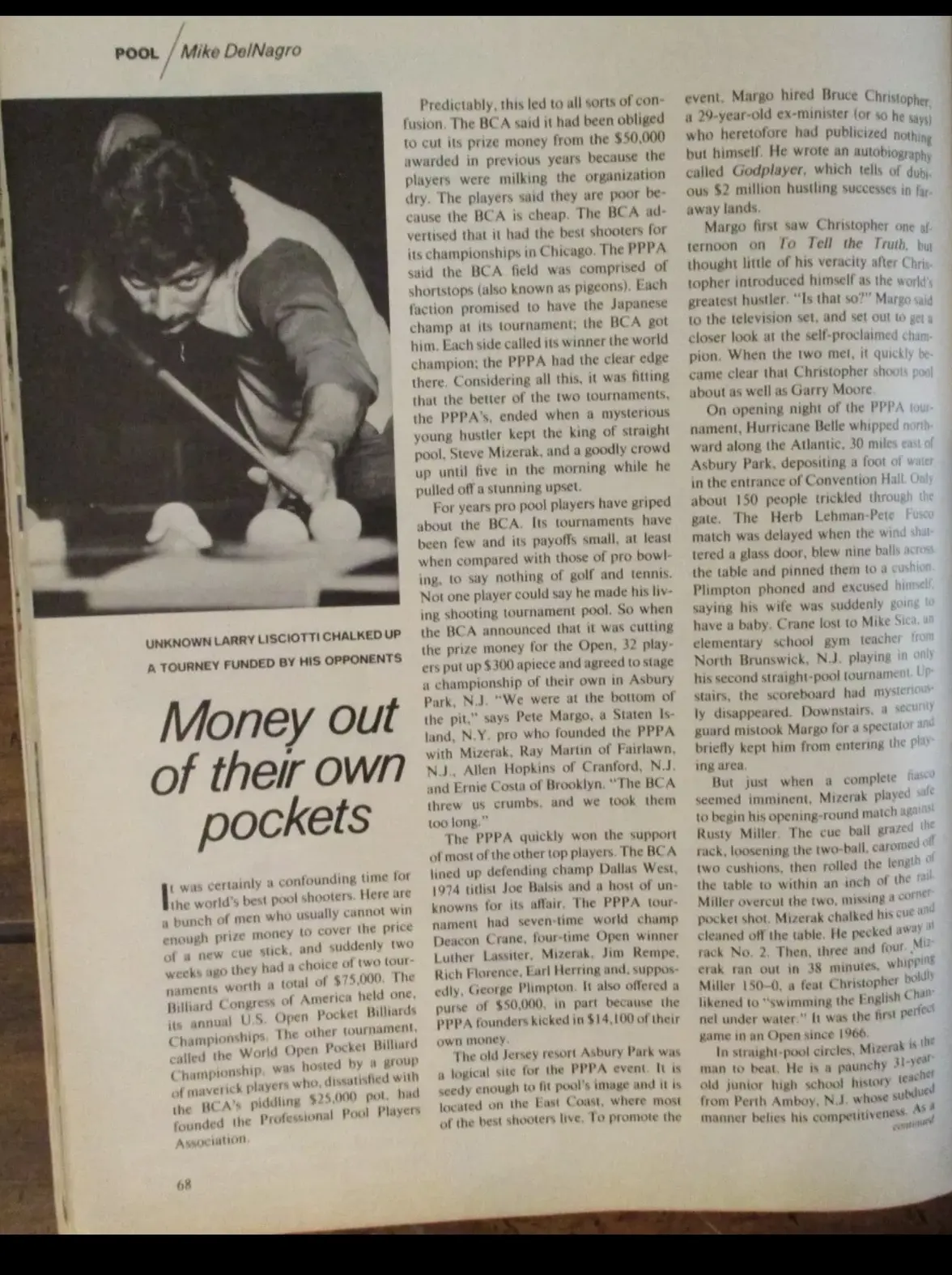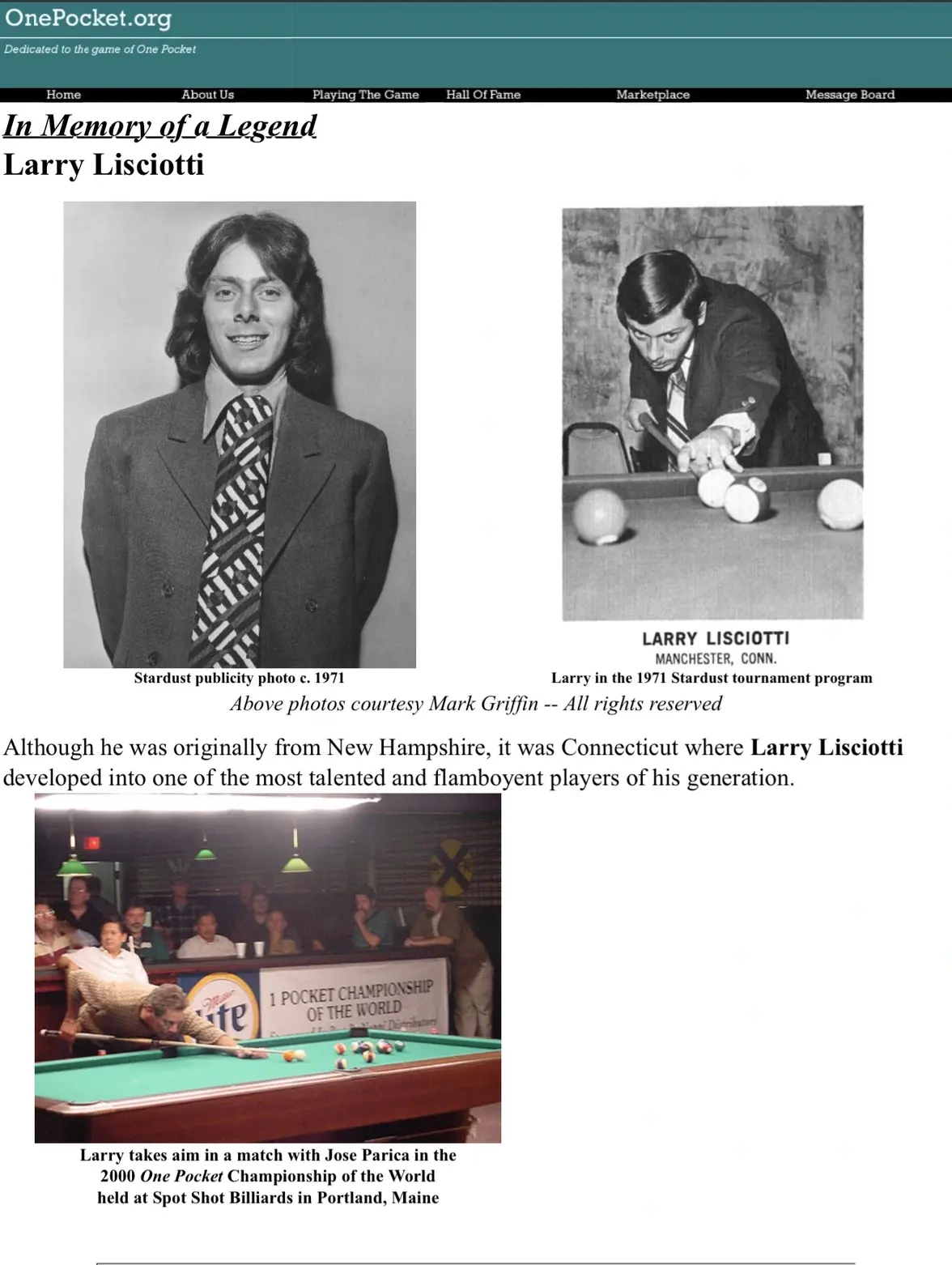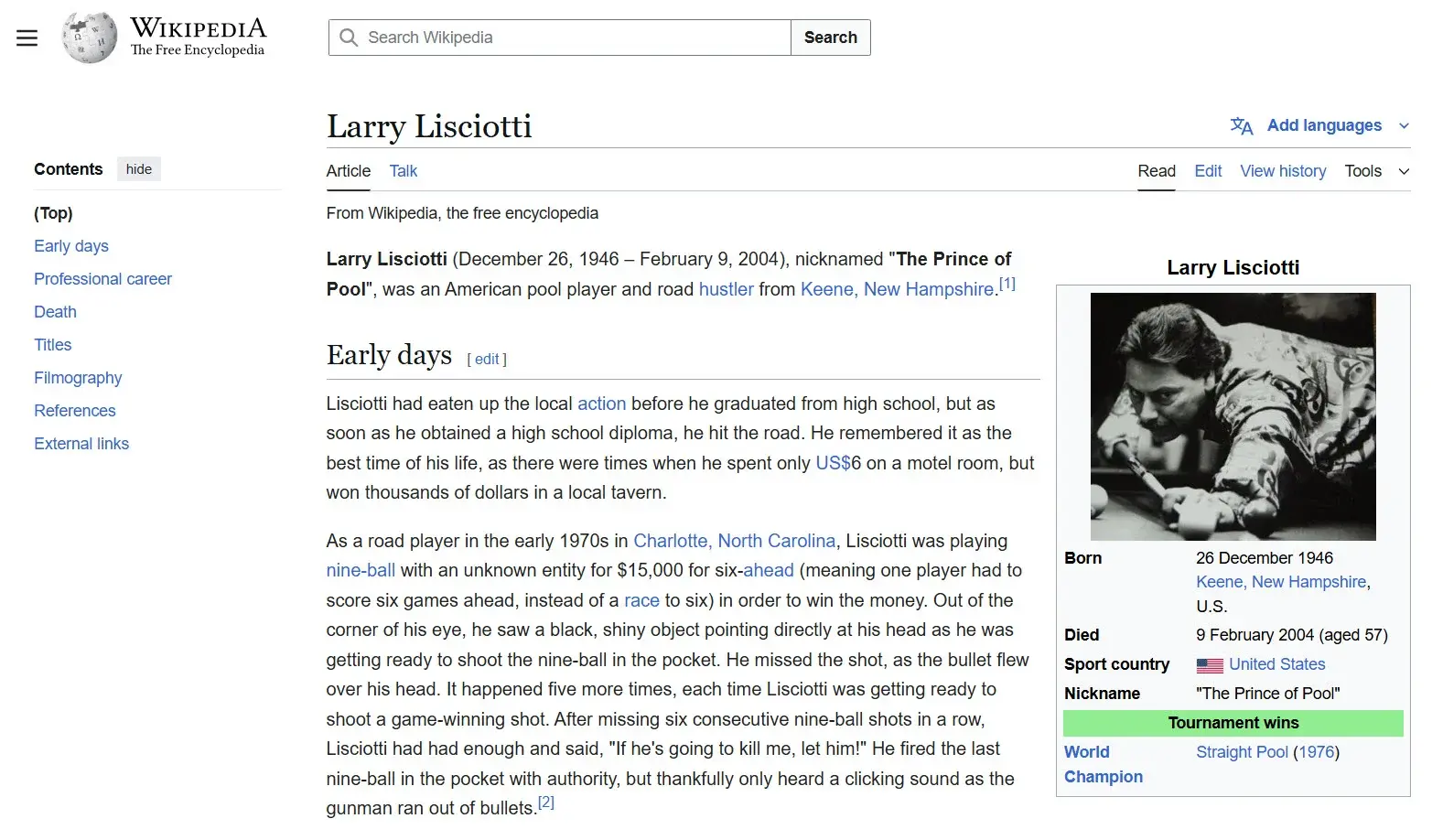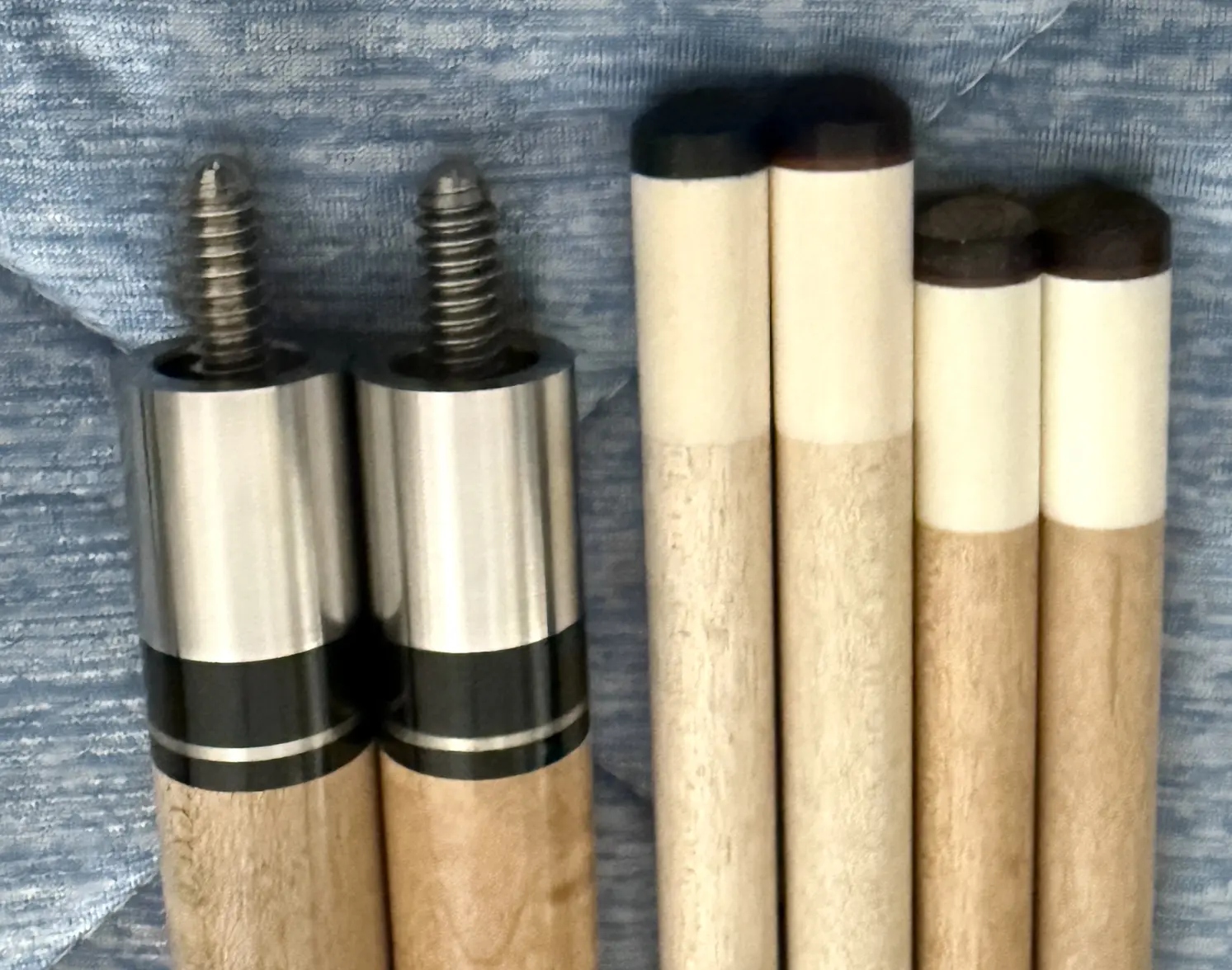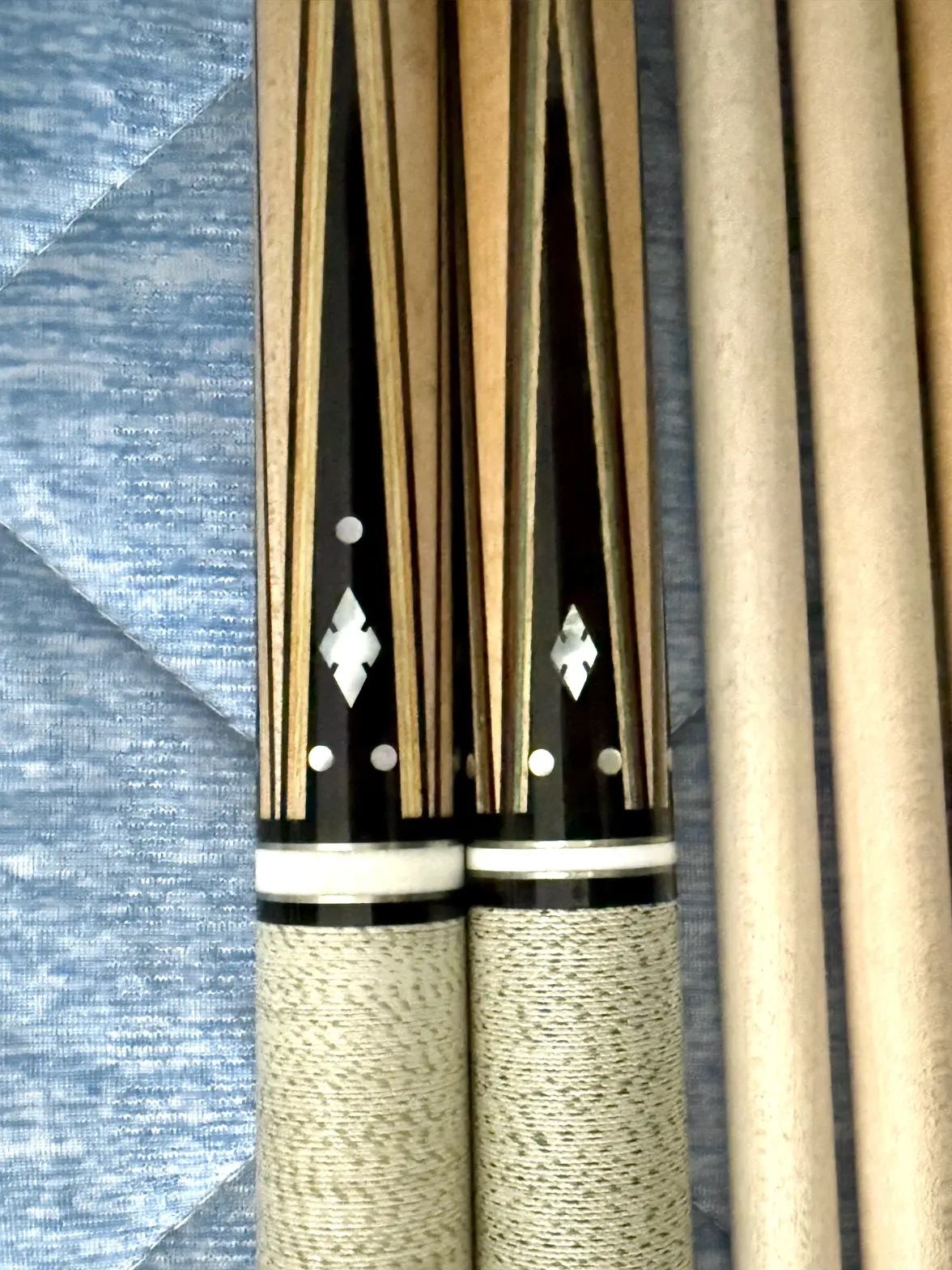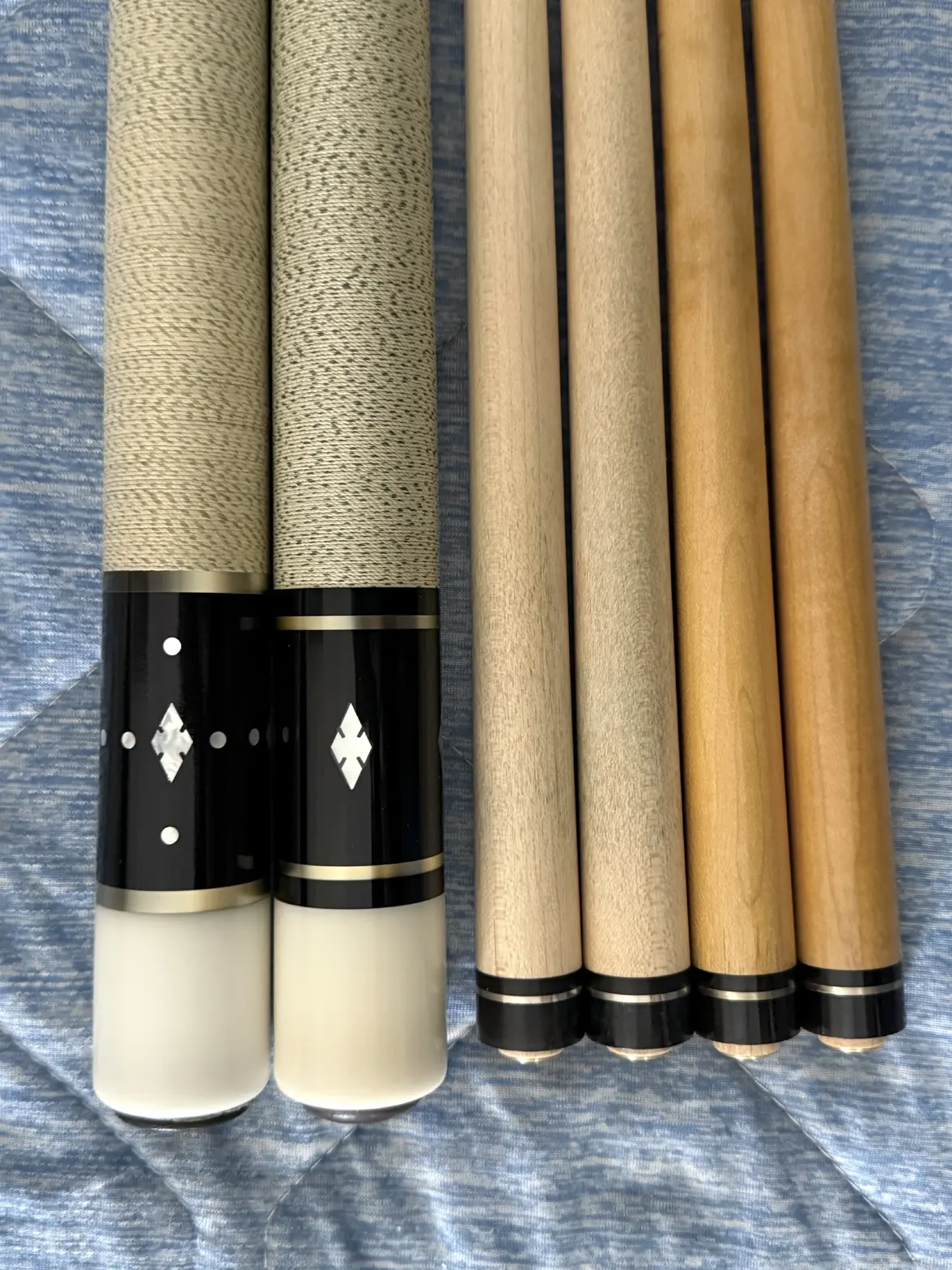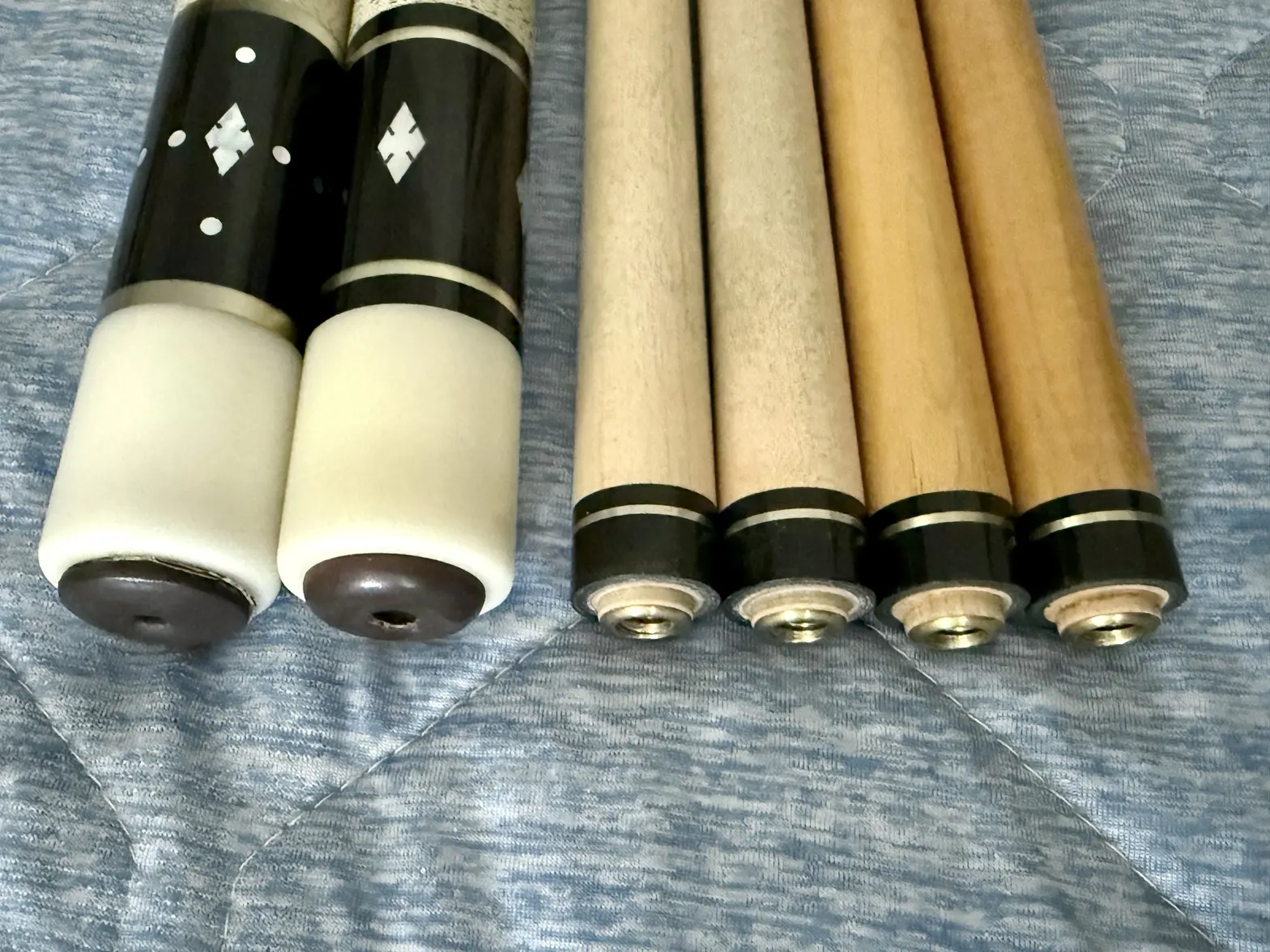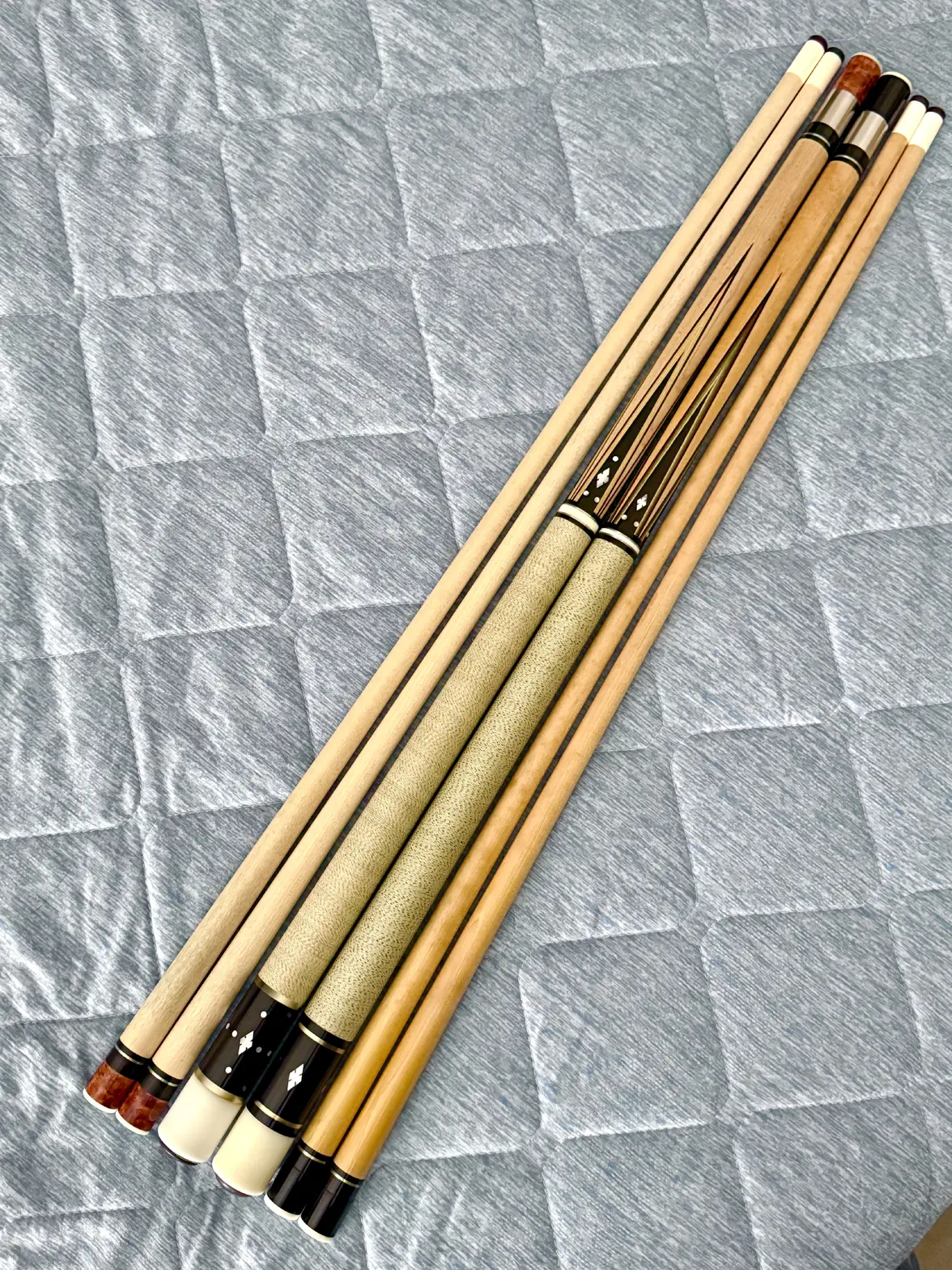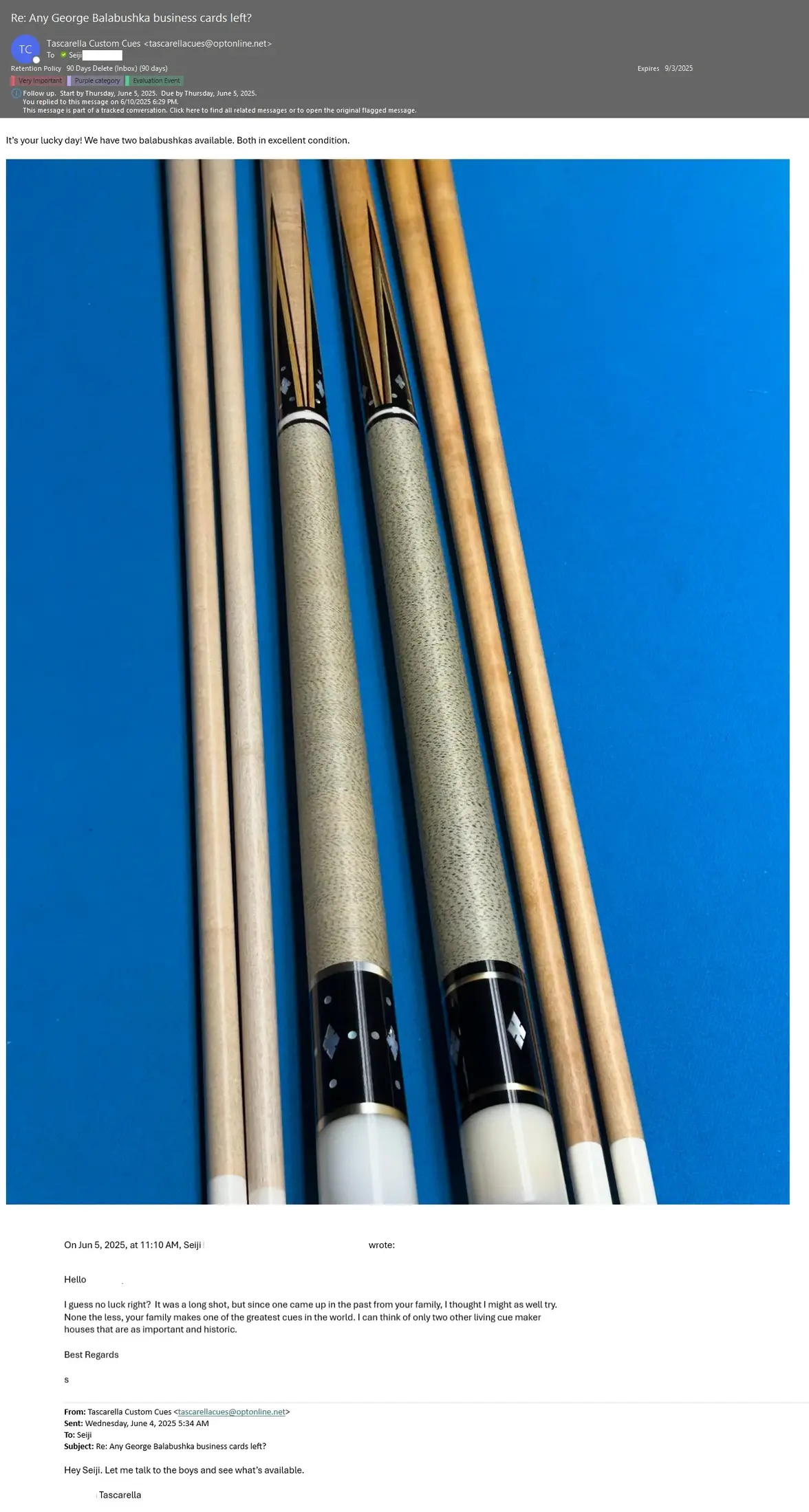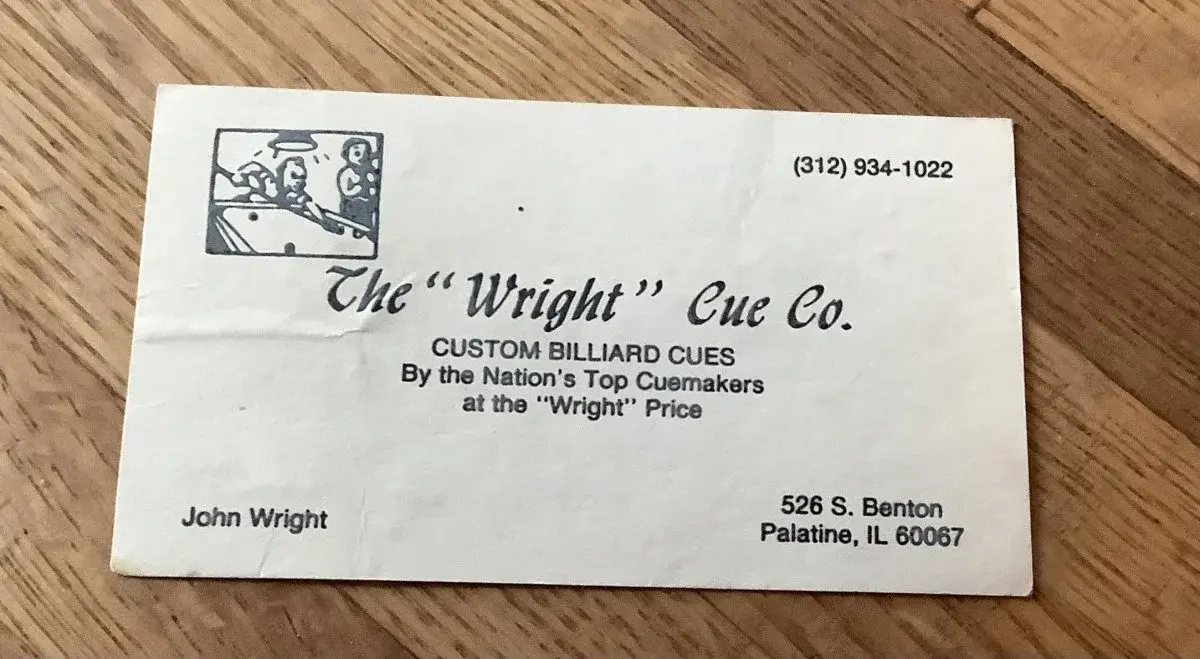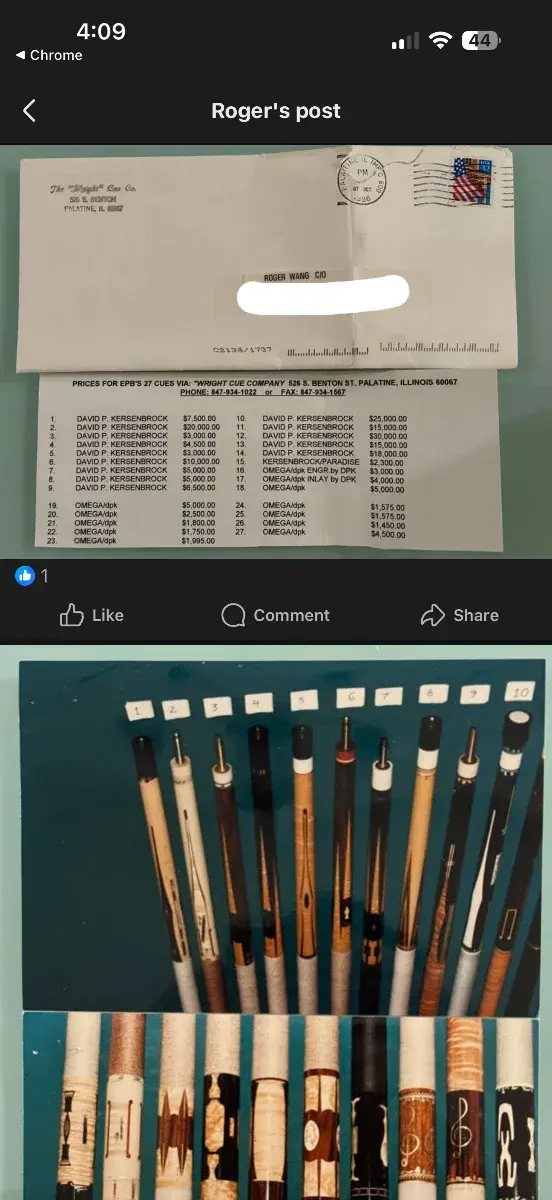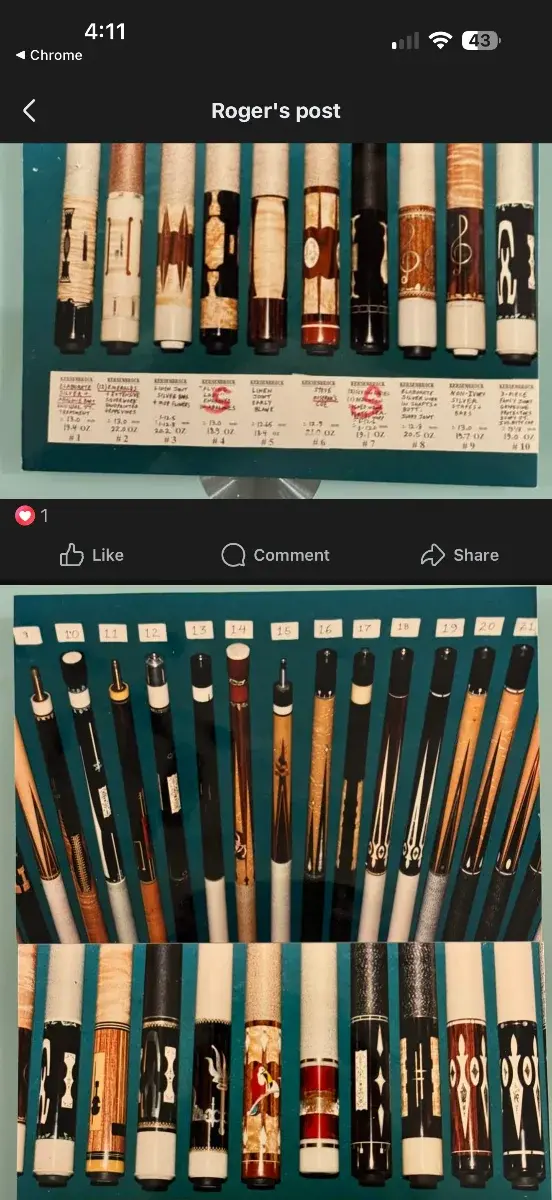Lépine
·At the hight of American Pocket Pool, many names stood out. One was Larry "The Prince of Pool" Lisciotti. His games used to be followed in Sports Illustrated magazine. He was one of the four "Road Runners" a notorious group of 1970s pool hustlers/pro tour players photographed in front of a white Rolls Royce to become an iconic photo hung in many sports clubs. He was the 1976 World Champion.
This was one of his cues from 1986-1991.
The cue is still nearly mint condition. It has been purchased directly from Peter Tascarella Sr. family who is regarded as the best expert authentication for George Balabushka cues. He visited Balabushka regularly and bought the equipment, notebooks, work in progress cues, and wood stock from Georges widow. Only Pete knows exactly all of George's secrets for building the legendary cues. If you have seen Tom Cruise in "The Color Of Money" then you know the name.
One other Larry Lisciotti/ Steve Mizerak owned George Balabushka sold privately for about $50,000. A cue with such a pedigree is rare.
The cue itself is built in Brooklyn New York in 1965 using a Burton Spain forearm. This cue is built during George Balabushka's second period when he transitions from his early years of a variety of experimentation with Brunswick Titleist house cues as a base for building his custom cues. The Burton Spain and later Gus Szamboti blanks cues are considered the most desireable periods when George Balabushka puts all of his experience into the legendary cues that attracted world champions. Just about all the major champions owned or played professionally with George Balabushka cues during the 1970s. There is a distinctive feel and performance to his cues from this period. All modern cues owe much of their design to the innovations George came up with. In my opinion there were two schools of thought, the East Coast was mainly George Balabushka and on the West Coast was Harvey Martin. These two were the progenitors of the East and West Coast cuemakers that would later become Hall of Fame cuemakers. George Balabushka was the first of many to be recognized. This cue is an example of a "fancy" cue (as opposed to a "player" cue) . There certainly were much fancier Balabushka cues that came later, but this was definitely ornate for a Balabushka, it features serveral mother of pearl inlays, the more the better. It has the famous "Balabushka Ring" just above the original Corland Irish Linen wrap (linen fishing line). It also has gold acrylic rings and a acrylic black sleeve. And finally, it has 4 colors of veneers. Today, this is not as impressive as it was for that era. Player cues tended to be very basic with only a shaft and plain butt with no additional work like points, veneers, and inlays to keep the cost down and construction simple. A cue with all the features of this cue would have been several times more expensive and more difficult to build by hand with no computer controlled equipement to insure the parts fit and are straight.
Many of the greatest cue makers of that era learned how wood behaves from other industries before they became cuemakers. Since there was no books or internet to look up how to make cues, these cuemakers learned from experience making furniture or as in George's case by making wooden toys for a number of years. George enjoyed the game and had a fascination with professional pool players. He is not known to have made cues often for common club players. He wanted his cues to be played by the best players and so he prioritized cues for the top professionals. It is estimated that during the 16 year career, George made roughly 1200 cues. It makes them rather rare to come across a genuine Balabushka.
Recently Peggy Mallen bought the rights to use the name George Balabushka for her line of China manufactured cues. Unfortunately this has caused quite a bit of confusion between the 1960s hand made originals made in New York using centuries old wood and her Balabushka brand cues that come off of Chinese assembly lines using cheap imported wood.
This was one of his cues from 1986-1991.
The cue is still nearly mint condition. It has been purchased directly from Peter Tascarella Sr. family who is regarded as the best expert authentication for George Balabushka cues. He visited Balabushka regularly and bought the equipment, notebooks, work in progress cues, and wood stock from Georges widow. Only Pete knows exactly all of George's secrets for building the legendary cues. If you have seen Tom Cruise in "The Color Of Money" then you know the name.
One other Larry Lisciotti/ Steve Mizerak owned George Balabushka sold privately for about $50,000. A cue with such a pedigree is rare.
The cue itself is built in Brooklyn New York in 1965 using a Burton Spain forearm. This cue is built during George Balabushka's second period when he transitions from his early years of a variety of experimentation with Brunswick Titleist house cues as a base for building his custom cues. The Burton Spain and later Gus Szamboti blanks cues are considered the most desireable periods when George Balabushka puts all of his experience into the legendary cues that attracted world champions. Just about all the major champions owned or played professionally with George Balabushka cues during the 1970s. There is a distinctive feel and performance to his cues from this period. All modern cues owe much of their design to the innovations George came up with. In my opinion there were two schools of thought, the East Coast was mainly George Balabushka and on the West Coast was Harvey Martin. These two were the progenitors of the East and West Coast cuemakers that would later become Hall of Fame cuemakers. George Balabushka was the first of many to be recognized. This cue is an example of a "fancy" cue (as opposed to a "player" cue) . There certainly were much fancier Balabushka cues that came later, but this was definitely ornate for a Balabushka, it features serveral mother of pearl inlays, the more the better. It has the famous "Balabushka Ring" just above the original Corland Irish Linen wrap (linen fishing line). It also has gold acrylic rings and a acrylic black sleeve. And finally, it has 4 colors of veneers. Today, this is not as impressive as it was for that era. Player cues tended to be very basic with only a shaft and plain butt with no additional work like points, veneers, and inlays to keep the cost down and construction simple. A cue with all the features of this cue would have been several times more expensive and more difficult to build by hand with no computer controlled equipement to insure the parts fit and are straight.
Many of the greatest cue makers of that era learned how wood behaves from other industries before they became cuemakers. Since there was no books or internet to look up how to make cues, these cuemakers learned from experience making furniture or as in George's case by making wooden toys for a number of years. George enjoyed the game and had a fascination with professional pool players. He is not known to have made cues often for common club players. He wanted his cues to be played by the best players and so he prioritized cues for the top professionals. It is estimated that during the 16 year career, George made roughly 1200 cues. It makes them rather rare to come across a genuine Balabushka.
Recently Peggy Mallen bought the rights to use the name George Balabushka for her line of China manufactured cues. Unfortunately this has caused quite a bit of confusion between the 1960s hand made originals made in New York using centuries old wood and her Balabushka brand cues that come off of Chinese assembly lines using cheap imported wood.
Edited:
